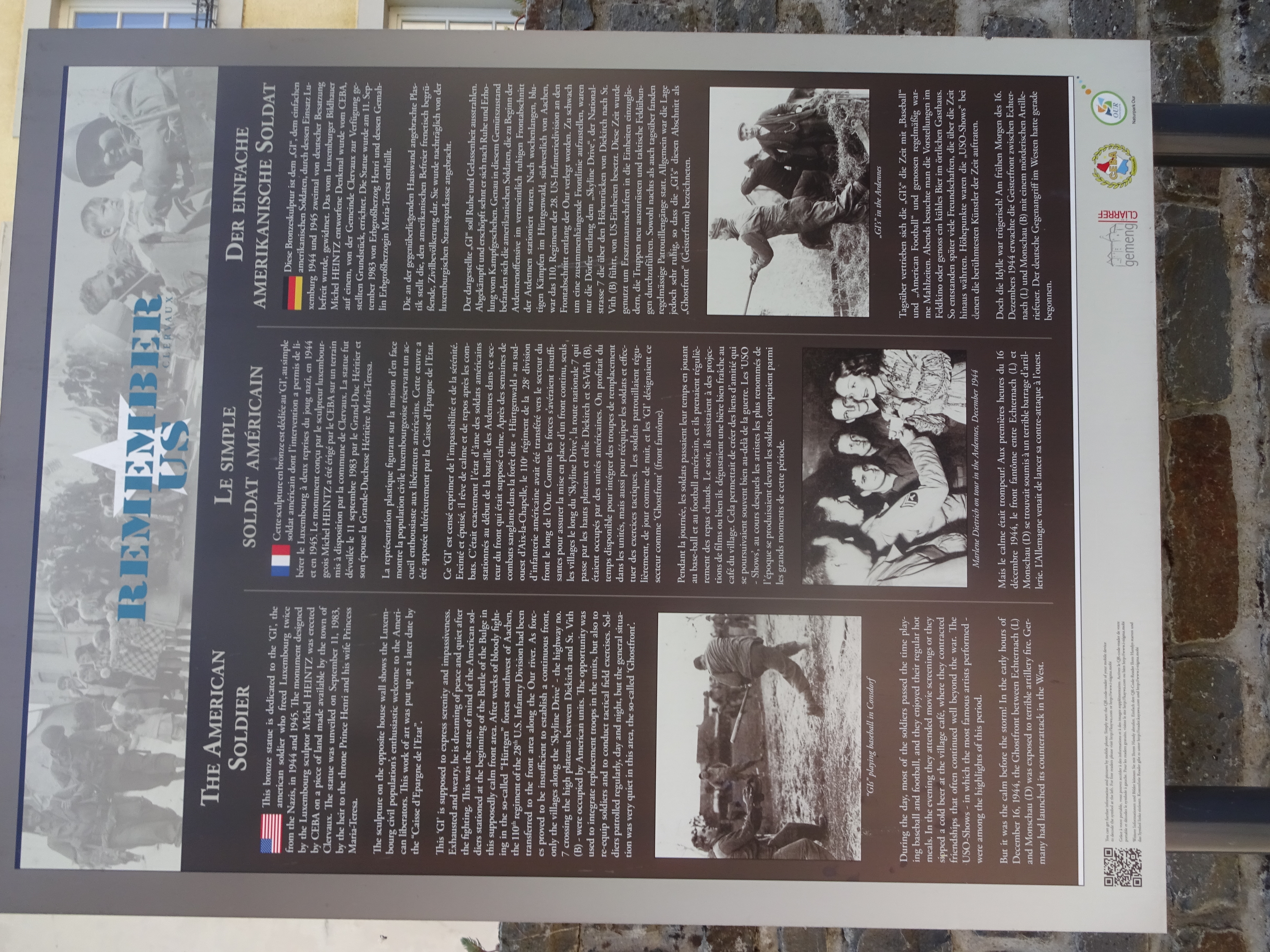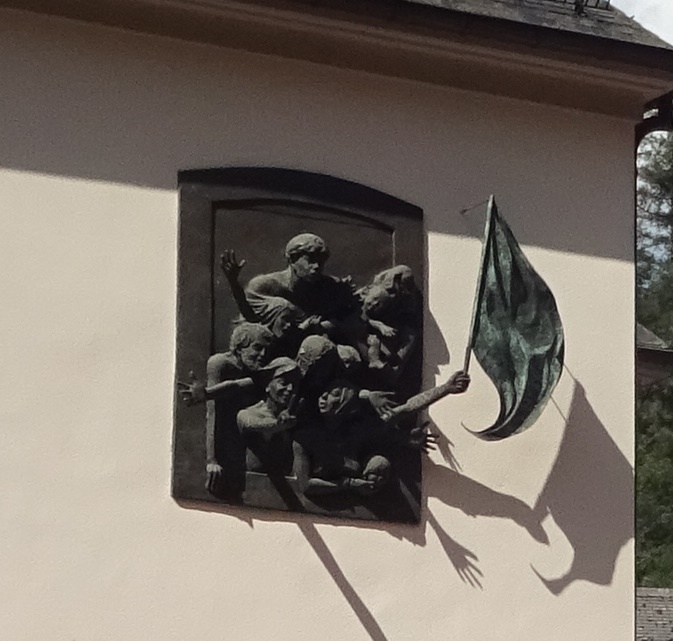The American Soldier - Information Panel
Details:
At the edge of the traffic circle that the monument is the center of. Marker A framed information panel in English, French, and German giving background on the sculpture and the soldiers stationed in this area prior to the "Battle of the Bulge".
Monument Text:
R E M E M B E R
CLERVAUX
U S
1st column in English:
THE AMERICAN
SOLDIER
This bronze statue is dedicated to the 'GI', the american soldier who freed Luxembourg twice from the Nazis, in 1944 and 1945. The monument designed by the Luxembourg sculptor Michel HEINTZ was erected by CEBA on a piece of land made available by the town of Clervaux. The statue was unveiled on September 11, 1983, by the heir to the throne Prince Henri and his wife Princess Maria-Teresa.
The sculpture on the opposite house wall shows the Luxembourg civil population's enthusiastic welcome to the American liberators. This work of art was put up at a later date by the "Caisse d'Epargne de l'Etat".
This 'GI' is supposed to express serenity and impassiveness. Exhausted and weary, he is dreaming of peace and quiet after the fighting. This was the state of mind of the American soldiers stationed at the beginning of the Battle of the Bulge in this supposedly calm front area. After weeks of bloody fighting in the so-called "Hürtgen" forest southwest of Aachen, the 110th regiment of the 28th U.S. Infantry Division had been transferred to the front area along the Our river. As forces proved to be insufficient to establish a continuous front, only the villages along the 'Skyline Drive' - the highway no. 7 crossing the high plateaus between Diekirch and St. Vith (B) - were occupied by American units. The opportunity was used to integrate replacement troops in the units, but also to re-equip soldiers and to conduct tactical field exercises. Soldiers patrolled regularly, day and night, but the general situation was very quiet in this area, the so-called 'Ghostfront'.
(-picture here-)
"GIs" playing baseball in Consdorf
During the day, most of the soldiers passed the time playing baseball and football, and they enjoyed their regular hot meals. In the evening they attended movie screenings or they sipped a cold beer at the village café, where they contracted friendships that often continued well beyond the war. The USO-Shows - in which the most famous artists performed - were among the highlights of this period.
But it was the calm before the storm! In the early hours of December 16, 1944, the Ghostfront between Echternach (L) and Monschau (D) was exposed to terrible artillery fire. Germany had launched its counterattack in the West.
2nd column in French:
LE SIMPLE
SOLDAT AMÉRICAIN
Cette sculpture en bronze est dédiée au 'GI', au simple soldat américain dont l'intervention a permis de libérer le Luxembourg à deux reprises du joug nazi, en 1944 et en 1945. Le monument conçu par le sculpteur luxembourgeois Michel HEINTZ a été érigé par le CEBA sur un terrain mis à disposition par la commune de Clervaux. La statue fut dévoilée le 11 septembre 1983 par le Grand-Duc Héritier et son épouse la Grande-Duchesse Héritière Maria Teresa.
La représentation plastique figurant sur la maison d'en face montre la population civile luxembourgeoise réservant un accueil enthousiaste aux libérateurs américains. Cette œuvre été apposée ultérieurement par la Caisse d'Epargne de l'Etat.
Ce 'GI' est censé exprimer de l'impassibilité et de la sérénité. Ereinté et épuisé, il rêve de calme et de repos après les combats. C'était exactement l'état d'âme des soldats américains stationnés au début de la bataille des Ardennes dans ce secteur du front qui était supposé calme. Après des semaines de combats sanglants dans la forêt dite « Hürtgenwald » au sudouest d'Aix-la-Chapelle, le 110e régiment de la 28e division d'infanterie américaine avait été transféré vers le secteur du front le long de l'Our. Comme les forces s'avéraient insuffisantes pour assurer la mise en place d'un front continu, seuls les villages le long du Skyline Drive', la route nationale 7 qui passe par les hauts plateaux et relie Diekirch et St-Vith (B), étaient occupés par des unités américaines. On profitait du temps disponible pour intégrer des troupes de remplacement dans les unités, mais aussi pour rééquiper les soldats et effectuer des exercices tactiques. Les soldats patrouillaient régulièrement, de jour comme de nuit, et les 'GI' désignaient ce secteur comme 'Ghostfront' (front fantôme).
Pendant la journée, les soldats passaient leur temps en jouant au base-ball et au football américain, et ils prenaient régulièrement des repas chauds. Le soir, ils assistaient à des projections de films ou bien ils dégustaient une bière bien fraîche au café du village. Cela permettait de créer des liens d'amitié qui se poursuivaient souvent bien au-delà de la guerre. Les 'USO - Shows', au cours desquels les artistes les plus renommés de l'époque se produisaient devant les soldats, comptaient parmi les grands moments de cette période.
(-picture here-)
Marlene Dietrich on tour in the Ardennes, December 1944
Mais le calme était trompeur! Aux premières heures du 16 décembre 1944, le front fantôme entre Echternach (L) et Monschau (D) se trouvait soumis à un terrible barrage d'artillerie. L'Allemagne venait de lancer sa contre-attaque à l'ouest.
3rd Column in German:
DER EINFACHE
AMERIKANISCHE SOLDAT
Diese Bronzeskulptur ist dem „GI", dem einfachen amerikanischen Soldaten, durch dessen Einsarz Luxemburg 1944 und 1945 zweimal von deutscher Besatzung befreit wurde, gewidmet. Das vom Luxemburger Bildhauer Michel HEINTZ entworfene Denkmal wurde vom CEBA, auf einem, von der Gemeinde Clervaux zur Verfügung gestellten Grundstück, errichtet. Die Statue wurde am 11. September 1983 von Erbgroßherzog Henri und dessen Gemahlin Erbgroßherzogin Maria-Teresa enthüllt.
Die an der gegenüberliegenden Hauswand angebrachte Plastik stellt die, den amerikanischen Befreier frenetisch begrüßende, Zivilbevölkerung dar. Sie wurde nachträglich von der luxemburgischen Staatssparkasse angebracht.
Der dargestellte „GI" soll Ruhe und Gelassenheit ausstrahlen. Abgekämpft und erschöpft sehnt er sich nach Ruhe und Erholung vom Kampfgeschehen. Genau in diesem Gemütszustand befanden sich die amerikanischen Soldaten, die zu Beginn der Ardennenoffensive im vermeintlich ruhigen Frontabschnitt der Ardennen stationiert waren. Nach wochenlangen, blutigen Kämpfen im Hürtgenwald, südwestlich von Aachen, war das 110. Regiment der 28. US-Infanteriedivision an den Frontabschnitt entlang der Our verlegt worden. Zu schwach um eine zusammenhängende Frontlinie aufzustellen, waren nur die Dörfer entlang dem „Skyline Drive", der Nationalstrasse 7 die über den Höhenrücken von Diekirch nach St. Vith (B) führt, von US-Einheiten besetzt. Diese Zeit wurde genutzt um Ersatzmannschaften in die Einheiten einzugliedern, die Truppen neu auszurüsten und taktische Feldübungen durchzuführen. Sowohl nachts als auch tagsüber fanden regelmässige Patrouillengänge statt. Allgemein war die Lage jedoch sehr ruhig, so dass die „Gi's“ diesen Abschnitt als „Ghostfront“ (Geisterfront) bezeichneten.
(-picture here-)
„GI's” in the Ardennes
Tagsüber vertrieben sich die „GI's“ die Zeit mit „Baseball“ und „American Football“ und genossen regelmäßig warme Mahlzeiten. Abends besuchte man die Vorstellungen im Feldkino oder genoss ein kühles Bier im örtlichen Gasthaus. So entstanden später viele Freundschaften, die über die Zeit hinaus währten. Höhepunkte waren die „USO-Shows" bei denen die berühmtesten Künstler der Zeit auftraten.
Doch die Idylle war trügerisch! Am frühen Morgen des 16. Dezembers 1944 erwachte die Geisterfront zwischen Echternach (L) und Monschau (B) mit einem mörderischen Artilleriefeuer. Der deutsche Gegenangriff im Westen hatte gerade begonnen.
Commemorates:
Units:
110th Infantry Regiment, 28th Division
17th Airborne Division
1st Army
26th Infantry Division
28th Infantry Division
2nd Armored Division
35th Infantry Division
3rd Armored Division
3rd US Army
4th Armored Division
4th Infantry Division
5th Infantry Division
7th Armored Division
80th Infantry Division
83rd Infantry Division
87th Infantry Division
8th Infantry Division
90th Infantry Division
94th Infantry Division
9th Armored Division
United States Army
Wars:
WWII
Battles:
Battle of the Bulge
Other images :



